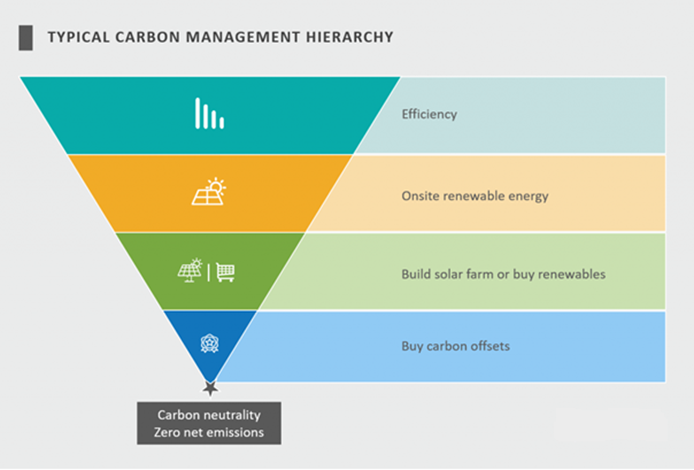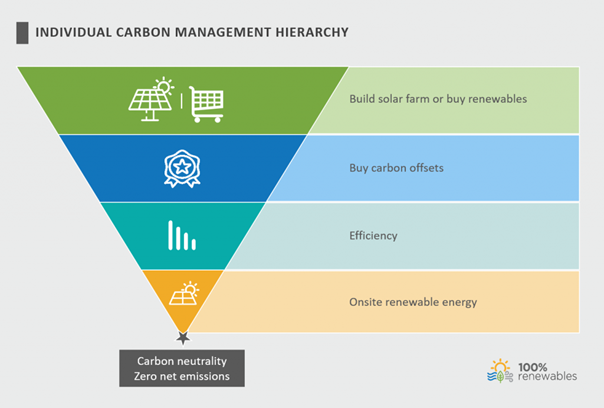Does the typical carbon management hierarchy apply to your business?
In these times of major claims to achieve Net Zero and carbon neutrality in the not too distant future, often clients are keen to understand how best to deliver carbon reduction actions, often in the context of what technologies and in what order. Ordinarily, we would suggest the ‘typical’ carbon management hierarchy such as that shown below.

Typical Carbon Management Hierarchy
The typical hierarchy suggests that a priority order of implementation should include:
- Energy efficiency: referred to as the ‘first fuel’, more efficient technologies, controls and practices helps to ensure that the least amount of energy is consumed before other measures are considered.
- Onsite solar PV: use of available roof space to implement solar PV to offset grid electricity consumption which is mainly produced from fossil fuels. Battery storage will enable solar PV systems to be expanded to offset a higher percent of onsite power demand in future.
- Offsite renewables: Power Purchase Agreements are becoming increasingly popular, particularly by large corporations and groups of organisations with similar aspirations and procurement processes. Some organisations have their own land and are interested in building their own solar farm to meet some or all of their energy needs.
- Carbon offsets: generally seen as the last step in a carbon management strategy, offsets are often purchased after all other ways to reduce carbon emissions have been exhausted.

Figure 2: Individual carbon management hierarchy for a client in a large heritage building
Every Organisation Has Unique Needs
However, while this approach is ‘ideal’, every business’ situation is different, and this approach may not represent the best strategy for everyone. Plus, technologies are changing and there are several different implementations that might happen sequentially or contemporaneously, but much needs to be considered before taking action, for example:
- Energy using technologies may be capital intensive or new energy efficiency opportunities may be limited.
- Onsite solar and batteries may be able to meet all of the energy demands of a warehouse operation for example. However old roofs, heritage buildings, multi-storey and energy-intensive facilities might have very limited PV capacity, or PV may only meet a small percent of energy demand.
- Onsite solar PV may actually be cheaper and deliver a better return on investment compared with many efficiency measures.
- New AI technologies can improve transparency and integration across the asset ecosystem therefore changing the mix of applications
- Purchasing renewables via a PPA is becoming increasingly cheaper and easier, particularly for large energy users. This may be a more efficient strategy than onsite solar opportunities as it can achieve emissions reduction at scale that other options cannot, and at similar or lower cost to ‘standard’ grid power.
- A business may have considerable Scope 3 carbon emissions that it has low ability to influence other than to purchase offsets; for example, flights, employee commute or catering expenses.
A business should tackle ambitious goals such as carbon neutrality with a multi-pronged approach that evaluates all of the abatement options and prioritises them based on what they can contribute to the end goal. The optimum carbon management hierarchy for each business may be different.

